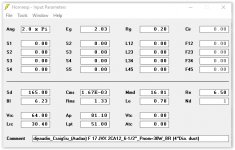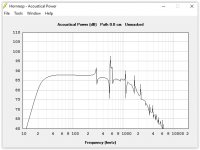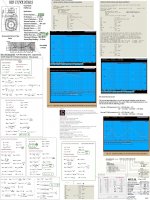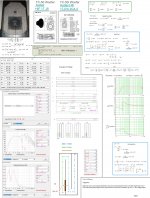I have 4 new-in-box Audax HIF17JVX (4 ohm) 6.5" drivers that have been in storage for 25 years. Due to their use of Velbex rubber surrounds and the quality of their paper cones they are in pristine condition. As many of you are aware they are the same woofers that were used in the famous Spica TC-50 monitors. The specs can be found here:
spicaspeakers.com/pdfs/audax-hif17jvx2ca.pdf
My initial thought was to use these as separate low-bass/subwoofers for a pair of stand-mounted monitors I was building at the time. The monitors were quarter wavelength transmission lines using the Audax HIF13HVX coupled with a stalk-mounted Audax TW74A tweeter. Anyway, the end result was that the monitors produced clean, useful bass notes down to 40 Hz so I never got around to using the HIF17JVX drivers.
I have a similar plan in mind now except to use them in separate cabinets to also be FAST bases for bipole MLTLs. Can these even be used in a successful subwoofer application? I see the spec sheet recommends a sealed enclosure. Since I have 4 of them would these benefit from a push-pull or Isobarik alignment? What about aperiodic or even passive radiator?
Or, if the commentariat declares it so, should I just save them for a nice MTM design further down the road? Thanks for reading. Any and all constructive input is greatly appreciated and feel free to provide details. If I don't understand something I'll keep asking and researching until I do.
spicaspeakers.com/pdfs/audax-hif17jvx2ca.pdf
My initial thought was to use these as separate low-bass/subwoofers for a pair of stand-mounted monitors I was building at the time. The monitors were quarter wavelength transmission lines using the Audax HIF13HVX coupled with a stalk-mounted Audax TW74A tweeter. Anyway, the end result was that the monitors produced clean, useful bass notes down to 40 Hz so I never got around to using the HIF17JVX drivers.
I have a similar plan in mind now except to use them in separate cabinets to also be FAST bases for bipole MLTLs. Can these even be used in a successful subwoofer application? I see the spec sheet recommends a sealed enclosure. Since I have 4 of them would these benefit from a push-pull or Isobarik alignment? What about aperiodic or even passive radiator?
Or, if the commentariat declares it so, should I just save them for a nice MTM design further down the road? Thanks for reading. Any and all constructive input is greatly appreciated and feel free to provide details. If I don't understand something I'll keep asking and researching until I do.
Hi,
Push pull perhaps. Due to the high Vas clamshell isobaric
sealed (which is also push pull) is a possibility. I can't
see aperoidic or a PR working well with them at all.
rgds, sreten.
Push pull perhaps. Due to the high Vas clamshell isobaric
sealed (which is also push pull) is a possibility. I can't
see aperoidic or a PR working well with them at all.
rgds, sreten.
Using the given specs i did a bit of modelling… i'd suggest 40 litres sealed (F10<30Hz) or something like 90 litres tuned to 20 Hz (F6~20Hz) (a single driver). Don't forget room gain, which should match better with the sealed box.
dave
dave
Thank you, sreten and Dave, for your input. According to my ancient 3rd Edition (1987!) of Vance Dickason's Loudspeaker Design Cookbook the following will apply for a compound (Isobarik) configuration:
A. Qts will be the same as a single driver.
B. Fs will be the same as a single driver.
C. Vas (and associated box volume Vb) will be half that of a single driver.
(Now I'm thinking out loud so please correct me if I'm wrong.) Since these are 4 ohm units I would need to use a series connection but wired out of phase for push-pull, otherwise the resulting 2 ohm impedance from a parallel connection would put a potential strain on my amplifier (Classe Audio Seventy).
Using the rules of construction for Isobarik the box size would be half of Dave's recommended 90 litres (approx. 3 cf) for a single driver which is good because 45 litres (approx. 1.6 cf) will put me easily within WAF limits on size. I know that the woofers can be mounted at least 3 ways:
1. Face-to-face: Unacceptable WAF since one driver is usually mounted backwards on the outside of the cabinet. (Sreten, is this configuration the "clamshell" reference you made? If so, any advantages over methods 2 & 3?)
2. Back-to back: Acceptable WAF but are there any issues with the magnet structures being so close in the tunnel that connects them?
3. Front-to-back: Also acceptable WAF but must take care that the rear cone doesn't contact the front magnet.
Your replies are great information and give me much food for thought. Any further input or clarifications regarding my thinking are much appreciated. I currently have 2 full range monitor designs in process (gifts that must be completed by this summer's end) so it will be a few months before the HIF17JVX project is started but I like to rummage through my plans well in advance.
A. Qts will be the same as a single driver.
B. Fs will be the same as a single driver.
C. Vas (and associated box volume Vb) will be half that of a single driver.
(Now I'm thinking out loud so please correct me if I'm wrong.) Since these are 4 ohm units I would need to use a series connection but wired out of phase for push-pull, otherwise the resulting 2 ohm impedance from a parallel connection would put a potential strain on my amplifier (Classe Audio Seventy).
Using the rules of construction for Isobarik the box size would be half of Dave's recommended 90 litres (approx. 3 cf) for a single driver which is good because 45 litres (approx. 1.6 cf) will put me easily within WAF limits on size. I know that the woofers can be mounted at least 3 ways:
1. Face-to-face: Unacceptable WAF since one driver is usually mounted backwards on the outside of the cabinet. (Sreten, is this configuration the "clamshell" reference you made? If so, any advantages over methods 2 & 3?)
2. Back-to back: Acceptable WAF but are there any issues with the magnet structures being so close in the tunnel that connects them?
3. Front-to-back: Also acceptable WAF but must take care that the rear cone doesn't contact the front magnet.
Your replies are great information and give me much food for thought. Any further input or clarifications regarding my thinking are much appreciated. I currently have 2 full range monitor designs in process (gifts that must be completed by this summer's end) so it will be a few months before the HIF17JVX project is started but I like to rummage through my plans well in advance.
Last edited:
Using the given specs i did a bit of modelling… i'd suggest 40 litres sealed (F10<30Hz) or something like 90 litres tuned to 20 Hz (F6~20Hz) (a single driver). Don't forget room gain, which should match better with the sealed box.
dave
Having reread your suggestions I believe I misunderstood them. To clarify:
40 litres: 1 or 2 drivers per cabinet? If 2, Isobarik or straight sealed cabinet?
90 litres: 1 driver, sealed or vented?
I apologize for any confusion on my part.😕
40 litres, 1 driver sealed. Use 2 then 80, isobaric, 20 + the coupling chamber.
90 litres, 1 driver vented. Use 2 then 180, isobaric, 45 + the coupling chamber.
I'd put the 2 in 80 litres sealed. Maybe a bit smaller and use lots of stuffing.
dave
90 litres, 1 driver vented. Use 2 then 180, isobaric, 45 + the coupling chamber.
I'd put the 2 in 80 litres sealed. Maybe a bit smaller and use lots of stuffing.
dave
Thank you for straightening me out, Dave. The 2 driver, 80 litre sealed configuration would allow me the option of bipoling the woofers with the full range bipole cabinet as well. It's always good to have options.
Regarding slightly reducing the volume, maybe reduce it to 70-75 litres and stuff at 1 lb/cf?
Regarding slightly reducing the volume, maybe reduce it to 70-75 litres and stuff at 1 lb/cf?
Hi CraigSu,
There is still a lot of data needed to arrive at an optimum suggestion, e.g.: external volume and aspect ratio, desired maximum volume, and I have not been able to find the Xmax parameter for the Audax driver. That makes it hard to evaluate how well suited this driver is for a subwoofer.
I recommend you download Hornresp, and use it to evaluate your options in addition to the good advice you are getting from Planet10. Hornresp gives you all the options to evaluate regular as well as isobaric systems (closed, vented, 1/4-wave). Keep an eye on the port particle velocity, if going vented you'll need at least a 3'Dia. (4"dia would be better) duct, or equivalent rectangular opening.
I'll attach a quick and rough example.
Regards,
There is still a lot of data needed to arrive at an optimum suggestion, e.g.: external volume and aspect ratio, desired maximum volume, and I have not been able to find the Xmax parameter for the Audax driver. That makes it hard to evaluate how well suited this driver is for a subwoofer.
I recommend you download Hornresp, and use it to evaluate your options in addition to the good advice you are getting from Planet10. Hornresp gives you all the options to evaluate regular as well as isobaric systems (closed, vented, 1/4-wave). Keep an eye on the port particle velocity, if going vented you'll need at least a 3'Dia. (4"dia would be better) duct, or equivalent rectangular opening.
I'll attach a quick and rough example.
Regards,
Attachments
That makes it hard to evaluate how well suited this driver is for a subwoofer.
You rarely want a subwoofer for LF use in a FAST.
Craig, it is hard to get the "wrong" volume for a sealed box. You can figure up to 20% effective volume increase with stuffing.
dave
Hi CraigSu,
There is still a lot of data needed to arrive at an optimum suggestion, e.g.: external volume and aspect ratio, desired maximum volume, and I have not been able to find the Xmax parameter for the Audax driver. That makes it hard to evaluate how well suited this driver is for a subwoofer.
I recommend you download Hornresp, and use it to evaluate your options in addition to the good advice you are getting from Planet10. Hornresp gives you all the options to evaluate regular as well as isobaric systems (closed, vented, 1/4-wave). Keep an eye on the port particle velocity, if going vented you'll need at least a 3'Dia. (4"dia would be better) duct, or equivalent rectangular opening.
I'll attach a quick and rough example.
Regards,
Thank you, Oliver. Yes, unfortunately Xmax seems to be one of those missing parameters that cannot be located. The link I've posted from the Spica website is the exact information from my old Madisound catalogs and is the only spec data I've ever seen for that driver. The comments do mention "long throw unit specially designed for low frequency reproduction." That's as close as we get I'm afraid.
Your recommendation of Hornresp was also very timely as I realized it was time to put away my "slide-rule" methods of design and look for some good (preferably free) modeling software. I'm curious as to what others use and recommend. I've seen the MJK spreadsheets mentioned but I'm uncertain as to whether or not they are still available for download (free or not).
I've also decided it's time to put away my drafting tools so I've downloaded SketchUp and will be plunging into that for cabinet design. If others have CAD-type recommendations I'm all ears.
Craig
I only use SketchUp for 3D visualizations. As a CAD tool it is somewhat limited. I use VectorWorks (on a Mac, there is a Windoz version but it suffers from Windozs) for doing actual CAD. Unless you are a student it is likely too pricey for casual use.
dave
dave
Even VectorWorks Fundamentals looks to be a bit pricey for me at $1895 USD. I do work for a school but I doubt I could afford even their educational pricing. Even though I used Windows from the earliest versions and spent 5 years at Microsoft supporting it (and DOS) I'm firmly in the Mac camp now. It's not any more perfect than Windows but I find the problems in OS X to be more straightforward and less vexing.
Craig
Craig
$1895… it has gone up. Last time i checked Ed pricing it was something like $140, certainly worth checking.
dave
dave
Hi CraigSu,
Post #10: "...I've also decided it's time to put away my drafting tools so I've downloaded SketchUp and will be plunging into that for cabinet design. If others have CAD-type recommendations I'm all ears."
I found little need for 3D sofar (that may change), Siemens makes Solid Edge available as Free 2D, seems quite full featured:
Free 2D: Siemens PLM Software
Regards,
Post #10: "...I've also decided it's time to put away my drafting tools so I've downloaded SketchUp and will be plunging into that for cabinet design. If others have CAD-type recommendations I'm all ears."
I found little need for 3D sofar (that may change), Siemens makes Solid Edge available as Free 2D, seems quite full featured:
Free 2D: Siemens PLM Software
Regards,
Hi Dave,
I don't know a thing about the MAC world, are there any emulators to run Windows programs (that work)?
Regards,
I don't know a thing about the MAC world, are there any emulators to run Windows programs (that work)?
Regards,
All modern Macs can run Windows natively and there are a number of virtualizers. But once you get used to the elegance of OS X, you try to avoid running Windoz. I certainly hate having to boot into XP to run WT2 -- it is a 3rd rate OS.
dave
dave
Bjorno:
Thank you for the extensive information! This may take me awhile to digest, much like a cow chewing its cud. If anyone wants to help simplify this for me I'm all ears.
So that's Hornresp. It doesn't make me want to go back to Windows but it does make me want something similar for the Mac. Given how much development has gone into it over the years I doubt I'll find something as good.
CraigSu
Thank you for the extensive information! This may take me awhile to digest, much like a cow chewing its cud. If anyone wants to help simplify this for me I'm all ears.
So that's Hornresp. It doesn't make me want to go back to Windows but it does make me want something similar for the Mac. Given how much development has gone into it over the years I doubt I'll find something as good.
CraigSu
I'm still struggling through Bjorno's detailed info but was just wondering if these Audax drivers would work well in a tapped horn (TH) design? At this point I'm still planning on the 80 liter sealed box arrangement suggested by Dave of Planet10 but since I currently have at least 3 other projects ahead of this one I have lots of time to consider the alternatives.
- Status
- Not open for further replies.
- Home
- Loudspeakers
- Subwoofers
- WAW / FAST feasible using Audax HIF17JVX?



